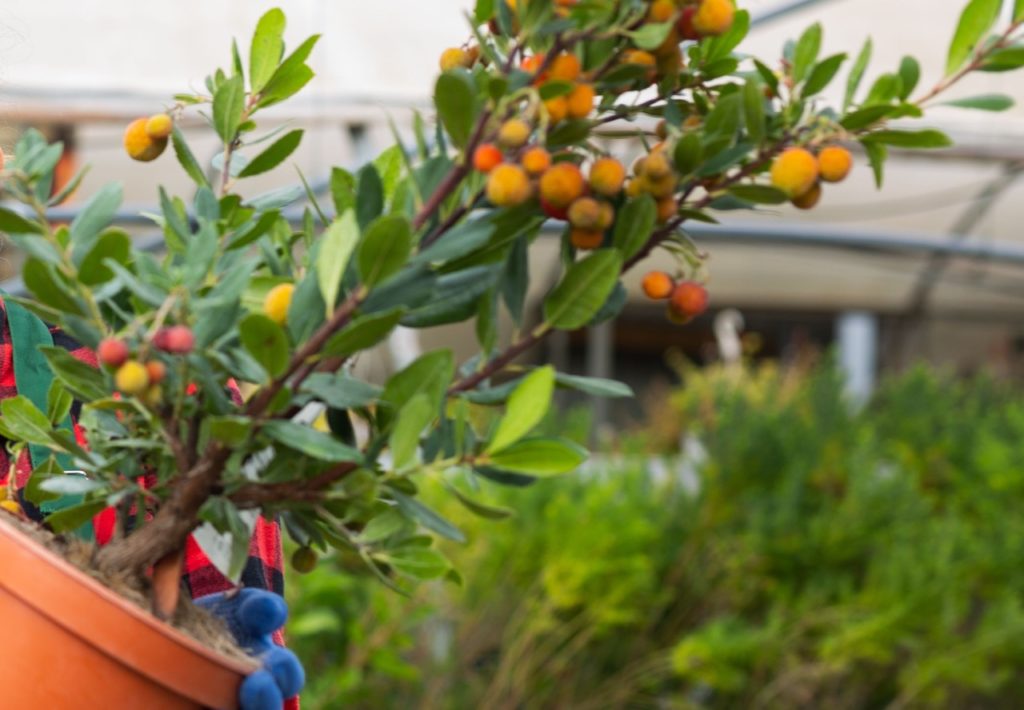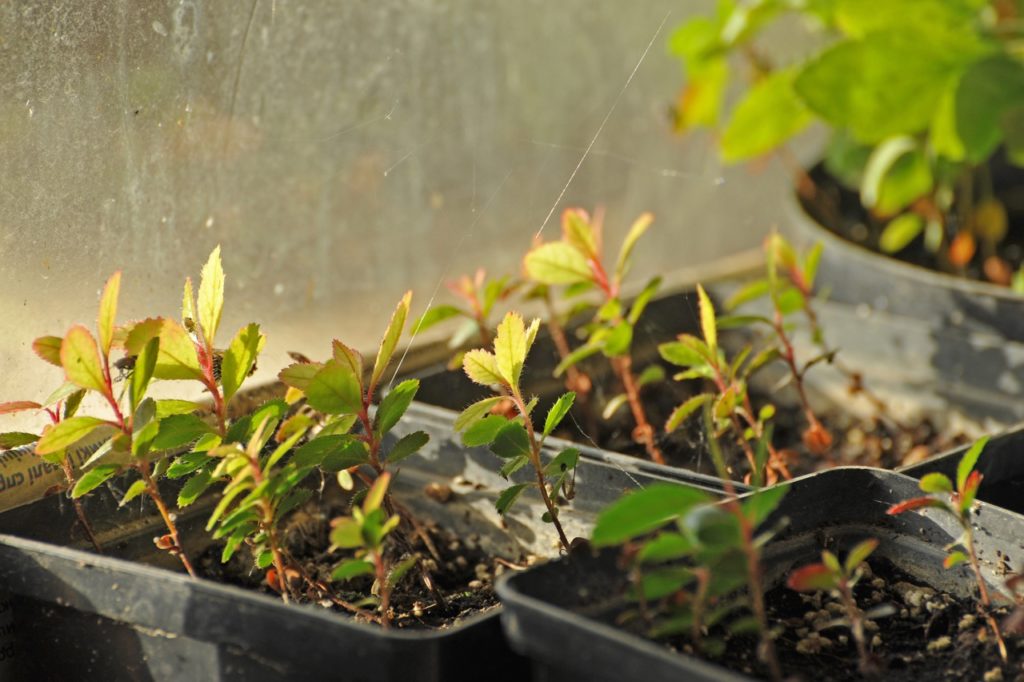TREE > ARBUTUS

Elizabeth is a Permaculture Garden Designer, Sustainability Consultant and Professional Writer, working as an advocate for positive change. She graduated from the University of St. Andrews with an MA in English and Philosophy and obtained a Diploma in Applied Permaculture Design from the Permaculture Association.
Reviewed By COLIN SKELLY

Colin is a Horticulturist and Horticultural Consultant with experience in a range of practical and managerial roles across heritage, commercial and public horticulture. He holds the Royal Horticultural Society’s Master of Horticulture award and has a particular interest in horticultural ecology and naturalistic planting for habitat and climate resilience.
Contributions From MANOJ MALDÉ
ARBUTUS GUIDES
If you are looking for a small evergreen tree for your garden which can also provide an edible yield, then the strawberry tree, Arbutus unedo, could be a good choice.
This tree is not native, though it is native to Southwest Ireland, but it can survive and even thrive in many UK gardens.
“Arbutus unedo is one of my favourite trees and I had two of the in my garden at the Chelsea Flower Show in 2017,” shares award-winning Garden Designer Manoj Maldé.
Overview
| Botanical Name | Arbutus unedo |
| Common Name(s) | Strawberry Tree |
| Plant Type | Tree / Shrub |
| Native Area | Southern Europe, Ireland and Asia |
| Hardiness Rating | H5 |
| Foliage | Evergreen |
| Flowers | White or pink bell-shaped blooms |
| When To Plant | September to November |
| Harvesting Months | November to December |
| When To Prune | February to March |
Sunlight
Preferred
Full Sun
Exposure
Sheltered
Size
Height
4 – 8M
Spread
4 – 8M
Bloom Time
Summer / Autumn
Soil
Preferred
Loam, sand or chalk
Moisture
Well-drained
pH
Any
Arbutus unedo is a large bushy shrub that is often pruned to give it a more tree-like form.
Although it is commonly referred to as the ‘Strawberry Tree’, this plant is not related to the common garden fruit you might be more familiar with.
This evergreen tree is a great choice for gardens, relatively compact in size and provides plenty of visual appeal throughout the year.
It is especially attractive between September and November, which is when the flowers and fruits are both born at the same time.

This tree is tolerant of a wide range of growing conditions and can be very resilient once established.
Opinions differ about how tasty the fruits may be, but they are edible.1Gardens, K. (n.d.). “Strawberry Tree.” Kew Royal Botanic Gardens. Retrieved March 9, 2023, from https://adoptaseed.kew.org/seed/strawberry-tree.html
“Perhaps the common name of Strawberry Tree sets the bar too high, but from experience, the fruits are not very tasty,” shares Colin Skelly, a Horticultural Consultant with experience that includes 5 years at The Eden Project.
“They do look good on the tree though. Arbutus unedo is also a wind-tolerant tree for coastal locations.”
They can be eaten raw and are often used to make preserves like jams and jellies, either on their own or in combination with other ingredients.
Common Varieties
In the UK, the Royal Horticultural Society has given two cultivars an Award of Garden Merit.

The first with an AGM is A. unedo f. rubra, which is a variant with pink flowers.

The second is the cultivar A. unedo ‘Atlantic’, with white flowers.
“I would, love an A. x andrachnoides in my current garden, but they are so hard to find,” says Manoj.
How To Grow Strawberry Tree
A. unedo works well as a stand-alone specimen tree, as part of a forest garden design or in a mixed border.
It is frequently used to stabilise and improve soils and is a pioneer plant often used in certain parts of the world in ecosystem restoration and to redress deforestation.2Strategies for the improvement of Arbutus unedo L. (strawberry tree): in vitro propagation, mycorrhization and diversity analysis. (2011). Universidade De Coimbra. Retrieved March 9, 2023, from https://core.ac.uk/download/pdf/19131968.pdf
It also can be used as an ornamental in gardens.

It might be a good plant for where soils are poor and other fruiting trees or shrubs are failing to thrive.
This tree will do best in areas where the soil is free-draining, as it cannot cope with waterlogged soil.
Even though it is in the Ericaceae plant family, most of which are acid-loving plants, it is unfussy about pH and can even cope with alkaline conditions.
Planting
Arbutus unedo trees are best purchased and planted in the autumn.
You should think carefully about where you initially plant them, as these trees do not always take well to transplantation.

Younger trees are best purchased because these will usually establish most easily.
Dig a hole large enough to accommodate the root system and then place the tree inside.
Fill back the soil around the tree, water in well and then mulch with organic matter.
Growing From Seed
Though A. unedo can be grown from seed, this can be challenging and is a time-consuming process, so most gardeners will choose to purchase this plant instead.
Seeds need to go through a month-long period of cold stratification and are then soaked in warm water for 5-6 days to improve germination rates.

Even after this, germination success rates rarely exceed around 20%.
Seedings are very fussy and are prone to damping off and fungal issues.
They will need to be mollycoddled for their first year.
Strawberry Tree Care
Light & Aspect
This tree needs full sun to fruit well and should be placed in a sheltered position here in the UK.
A south or west-facing aspect is ideal.
In small spaces, this tree might be espaliered against a south-facing wall.
Overwintering
A. unedo will survive temperatures down to -15°C and has a hardiness rating of H5.
Watering & Feeding
Water regularly during dry spells until the tree becomes established.
Once mature, the tree should have reasonable drought tolerance.

Replenish the mulch around the tree each spring to provide fertility, retain moisture and suppress weeds.
It is also a good idea to consider creating a guild with beneficial companion plants around this fruit tree (see below).
Pruning
Pruning is not usually required and any pruning should be light.
Simply remove dead, damaged, diseased or poorly-placed branches in the late winter or early spring.
Common Pests & Diseases
The tree is susceptible to aphids, though this can be easily handled by attracting wildlife that eats them to your garden through companion planting.

Aim for as much biodiversity in your garden as possible.
Though usually not plagued by many issues, Arbutus leaf spot is one problem that may occur.
Propagating
Though seed propagation is challenging, it is, of course, possible.
An easier way to propagate these trees is through semi-ripe cuttings taken during the summer months.
Companion Planting
You should consider making a guild of beneficial companion plants, which might include:
- Spring-flowering bulbs
- Yarrow
- Comfrey
- Clovers
- Mediterranean herbs
FAQs
Where Is Arbutus Unedo Native To?
A. unedo is native to Southern Europe, Southwest Ireland and Asia.
How Tall Does A Strawberry Tree Grow?
Typically somewhere between 4-8m tall and wide.
Can You Eat Fruit From A Strawberry Tree?
Yes, as mentioned above, fruits can be eaten raw or used in a range of delicious recipes or preserves.
What Can You Plant Under An Arbutus Tree?
There are many plants that work well under an Arbutus tree.

See the examples in the section on companion planting above.
Chopping and dropping guild plants for autumn can give a soft cushion below the tree which will protect the fruits that are collected from the ground after they fall from the tree.
References
- 1Gardens, K. (n.d.). “Strawberry Tree.” Kew Royal Botanic Gardens. Retrieved March 9, 2023, from https://adoptaseed.kew.org/seed/strawberry-tree.html
- 2Strategies for the improvement of Arbutus unedo L. (strawberry tree): in vitro propagation, mycorrhization and diversity analysis. (2011). Universidade De Coimbra. Retrieved March 9, 2023, from https://core.ac.uk/download/pdf/19131968.pdf


